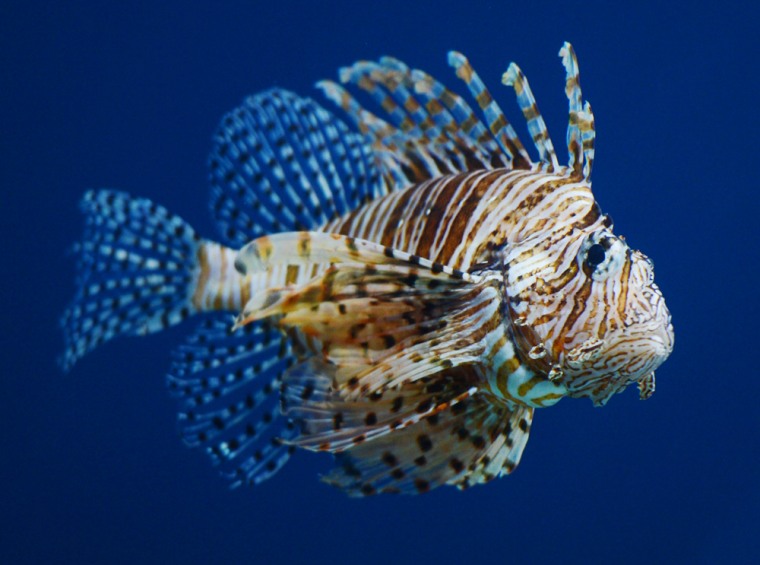A federal plan to battle invasive lionfish by dishing them up on America’s dinner plates may have backfired with the news that the flamboyantly-finned creatures can harbor a potentially dangerous neurotoxin.
Two years ago, officials with NOAA, the National Oceanic and Atmospheric Administration, launched a well-publicized campaign, complete with flashy pull-cards, a lionfish cookbook and a catchy slogan. As one newsletter put it, “If we can’t beat them, let’s eat them."
The effort was aimed at harnessing the power of the U.S. appetite to help battle the voracious fish that has spread far from its native Pacific waters to ravage the reef ecosystems of the U.S. Southeast and the Caribbean.
“Once stripped of its venomous spines, cleaned and filleted like any other fish, the lionfish becomes delectable seafood fare,” NOAA officials enthused.
But another government agency, the Food and Drug Administration, now frowns on the “Eat Lionfish” campaign after tests of nearly 200 lionfish show that more than a quarter exceed federal levels for a toxin that can cause ciguatera, a potentially dangerous fish food poisoning.
“We certainly don’t promote any campaign like that since we have found levels above our guidance,” said Alison Robertson, the FDA’s lead ciguatera researcher for the chemical hazards branch of the Gulf Coast Seafood laboratory. “It certainly wouldn’t be our recommendation at this time.”
Robertson said she and other FDA scientists decided to test the lionfish in the summer of 2010 after hearing about NOAA’s gustatory effort.
Of 194 fish tested, 42 percent showed detectable levels of ciguatoxin and 26 percent were above the FDA’s illness threshold of 0.1 parts per billion.
That’s enough to potentially sicken a diner with the illness that causes not only typical food poisoning symptoms – diarrhea, vomiting and fatigue – but also neurological problems such as painfully tingling hands and feet, a feeling of having loose teeth, and, oddest of all, a reversed sense of temperature.
“Whatever I touched, if it was hot, it would feel cold. If it was cold, it felt hot,” ciguatera victim Pat Schroeder of Beaumont, Texas, told msnbc.com three years ago. “I couldn’t walk on the tile floor. It felt like it was burning me.”
At least 50,000 cases of ciguatera poisoning are reported worldwide each year, but the real figure may be 100 times higher, experts say. There are dozens of confirmed reports of ciguatera poisoning in the U.S. each year with more than 300 logged by the Centers for Disease Control and Prevention between 2005 and 2009, according to the agency’s database. There were 84 cases in 2007, for instance, including 29 people sickened at a single dinner party.
The link between lionfish and ciguatera is raised in an article in the latest issue of the Annals of Emergency Medicine.
The toxin that causes ciguatera is produced by microscopic sea plants, called dinoflagellates, which are eaten by small fish that are, in turn, eaten by larger fish such as snapper, grouper, sea bass and barracuda. The toxins become increasingly concentrated as they move up the food chain.
Because of that, ciguatera poisoning is usually caused by large reef fish such as amberjack. So far, none of the ciguatera cases confirmed in the U.S. has implicated lionfish, which makes some question the FDA’s caution.
“We have always known that all reef fish can have ciguatera fish poisoning,” said James Morris, a marine ecologist with the National Center for Coastal Ocean Science. “I was not surprised to hear that lionfish contain some toxin.”
The lionfish, dubbed “the Norwegian rats of the sea” by one scientist, are truly destructive, ruining the delicate habitat of every reef they overrun. They have invaded the coastal waters from North Carolina to the Bahamas, now outnumbering native species in some sites.
That’s reason enough to eat them, argues Michael Dimin, founder of Sea to Table, an organization that fosters relationships between fishermen and chefs.
“The best way to solve the lionfish problem is to sauté them,” he said.
No one wants to get ciguatera, but harvesting lionfish for the dinner table might be one way to preserve the ecosystem. As for the ciguatera risk, Dimin likened it to the risk of sticking yourself with your own dinner fork.
“The idea of trying to control the lionfish problem by eating them is a great one, and whatever small risk there is is outweighed by the benefit,” says Dimin, whose group co-sponsored the “Eat Lionfish” campaign.
Chef Barton Seaver, who has been described as an evangelist for sustainable seafood, says legitimate concerns about ciguatera should be balanced by responsible sourcing.
“Nobody wants to serve neurotoxins for dinner,” he said. “I would trust the supply chain.”
The volume of lionfish used in the U.S. totals hundreds, not thousands of pounds, and it’s expensive -- about $16 a pound compared with snapper, which is going for about $8.45.
Seaver says he likes to prepare lionfish in a nice ceviche, as part of a robust romesco sauce or stewed into a tasty curry.
Those dishes may sound delicious, but Robertson, the scientist at the FDA, isn’t convinced.
“Particularly in areas where we know ciguatoxin is present, people should not be eating lionfish," she said. "Just like they shouldn’t be eating grouper or other reef predators.”
Related stories:
